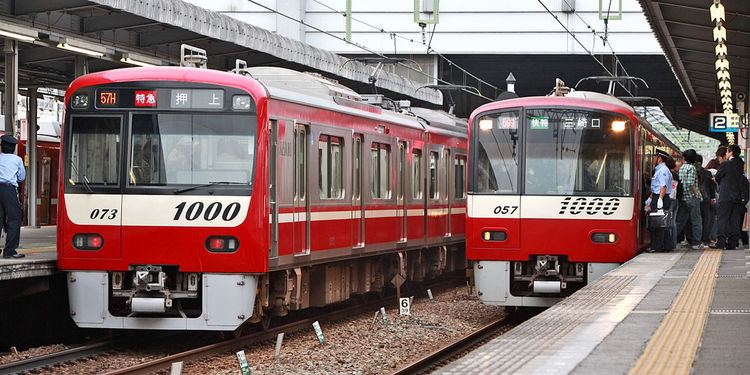In service March 2002–Present Number built 302 vehicles (51 sets) | Constructed 2002– Formation 4/6/8 cars per set | |
 | ||
Manufacturer Kawasaki Heavy Industries, Tokyu Car Corporation | ||
The Keikyu N1000 series (京急新1000形, Keikyū Shin-1000-gata) is a DC electric multiple unit (EMU) train type operated by the private railway operator Keikyu on commuter services in the Tokyo area of Japan since 2002.
Contents
- Operations
- Variants
- Batch 1
- Batch 2
- Batch 3
- Batch 4
- Batch 5
- Batch 6
- Batch 7
- Batch 8
- Batch 9
- Batch 10
- Batch 11
- Batch 12
- Batch 13
- 1000 1800 series
- Batch 16
- 8 car sets 1001 to 1033
- 8 car sets 1041 to 1065
- 8 car sets 1073 to 1145
- 6 car sets 1301 to 1313
- 4 car sets 1401 to 1405
- 4 car sets 1409 to 1413
- 4 car sets 1417 to 1445
- 4 car sets 1449 to 1489
- Livery variations
- References
Operations
The 8-car sets are primarily used on limited-stop "Rapid Limited Express" and "Limited Express" services on the Keikyu Main Line, including through-running services to and from the Toei Asakusa Line subway, Keisei Main Line, and Hokuso Line. 4-car sets are used to form 12-car "Rapid Limited Express" and "Limited Express" services, and are also used singly on all-stations "Local" services. The 6-car formations delivered from 2011 are generally used on all-stations "Local" services. The N1000 series sets can be used in multiple with other Keikyu EMU types, including the 600 series, 1500 series, 2000 series, and 2100 series.
Variants
Since the first set was introduced in March 2002, the type has undergone a number of design improvements. Sets built from 2002 to 2006 have painted aluminium bodies, whereas sets built from 2007 onward (sets 1073 onward) have unpainted stainless steel bodies. More detailed variations are described below.
Batch 1
Delivered February to June 2002.
Fitted with single-arm pantographs and roller-blind destination indicators from new. Use Siemens GTO variable-frequency drive (VVVF).
Batch 2
Delivered May to July 2003.
The centre pillars of the passenger windows were discontinued.
Batch 3
Delivered January to March 2005.
Feature IGBT variable-frequency drive.
Batch 4
Delivered July to August 2005.
Feature full-colour LED destination indicators.
Batch 5
Delivered November 2006.
No design changes over 4th batch vehicles.
Batch 6
Delivered March 2007.
Use Mitsubishi inverters. Body design changed to unpainted stainless steel. The 4-seat transverse bays at the ends of cars were replaced by longitudinal bench seats.
Batch 7
Delivered January to February 2008.
Yellow warning tape was added around the door interiors.
Batch 8
Delivered September to December 2008.
Batch 9
Delivered April to June 2009.
Batch 10
Delivered during fiscal 2010.
Audible warnings added for door opening/closing, and pairs of LCD passenger information screens installed above doors.
Batch 11
Delivered during fiscal 2011.
The third 6-car set, 1313, entered service on 19 March 2012. This set uses LED interior lighting instead of fluorescent tubes.
Batch 12
Delivered April 2012.
Batch 13
Delivered August 2013 to March 2014.
1000-1800 series
Two new 1000-1800 series four-car sets (1801 and 1805) were delivered from J-TREC in February 2016. These two sets differ from earlier variants in having centre gangways on the cab ends as well as a vinyl-based red and ivory livery. These two sets entered revenue service on 4 March 2016.
Batch 16
Introduced in fiscal 2016.
8-car sets 1001 to 1033
The five 8-car (aluminium bodied) sets 1001 to 1033 are formed as follows, with four motored (M) cars and four trailer (T) cars.
The "Tpu" and "Tps" cars are each fitted with two single-arm pantographs.
8-car sets 1041 to 1065
The five 8-car (aluminium bodied) sets 1041 to 1065 are formed as follows, with six motored (M) cars and two trailer (T) cars.
The "Tpu" and "Tps" cars are each fitted with two single-arm pantographs.
8-car sets 1073 to 1145
The ten 8-car (stainless steel bodied) sets 1073 to 1145 are formed as follows, with six motored (M) cars and two trailer (T) cars.
The "M1u" and "M1s" cars are each fitted with two single-arm pantographs, and the "M1u'" are fitted with one pantograph.
6-car sets 1301 to 1313
The three 6-car (stainless steel bodied) sets 1301 to 1313 are formed as follows, with four motored (M) cars and two trailer (T) cars.
The "M1u" and "M1s" cars are each fitted with two single-arm pantographs.
4-car sets 1401 to 1405
The two 4-car (aluminium bodied) sets 1401 to 1405 are formed as follows, with two motored (M) cars and two trailer (T) cars.
The "Tpu1" and "Tps1" cars are each fitted with one single-arm pantograph.
4-car sets 1409 to 1413
The two 4-car (aluminium bodied) sets 1409 to 1413 are formed as follows, with two motored (M) cars and two trailer (T) cars.
The "Tp" cars are fitted with two single-arm pantographs.
4-car sets 1417 to 1445
The eight 4-car (aluminium bodied) sets 1417 to 1445 are formed as follows, with three motored (M) cars and one trailer (T) car.
The "Tp" cars are fitted with two single-arm pantographs.
4-car sets 1449 to 1489
The eleven 4-car (stainless steel bodied) sets 1449 to 1489 are formed as follows, with four motored (M) cars.
The "M1u" and "M1s" cars are each fitted with one single-arm pantograph.
Livery variations
8-car set 1057 was repainted into a special "Yellow Happy Train" livery from May 2014.
